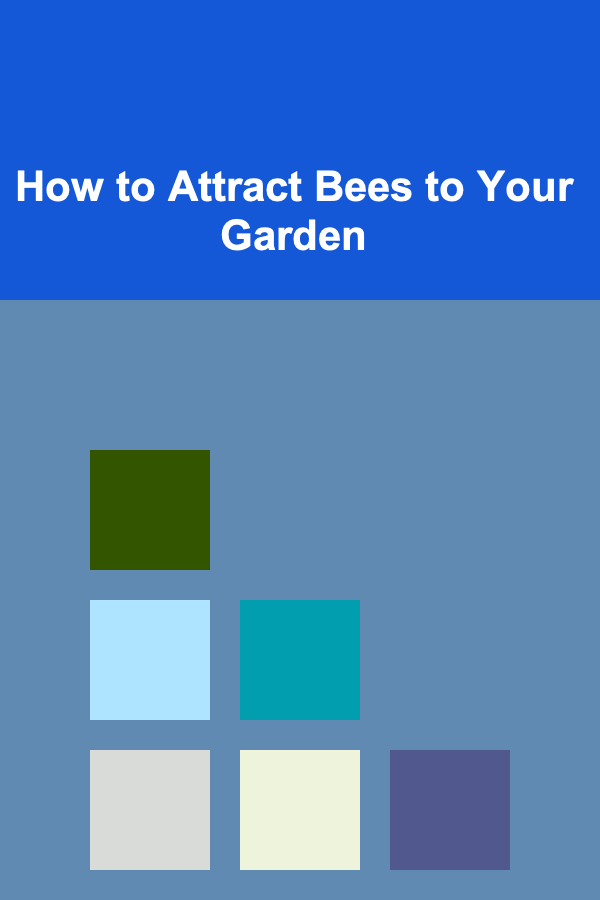
How to Attract Bees to Your Garden
ebook include PDF & Audio bundle (Micro Guide)
$12.99$5.99
Limited Time Offer! Order within the next:

Bees play a vital role in the ecosystem, and their presence is crucial for the pollination of many plants, including crops that humans rely on for food. However, bee populations have been declining in recent years due to factors like habitat loss, pesticide use, and climate change. One way to help reverse this decline is by creating a bee-friendly environment in your own backyard. In this article, we'll explore various ways to attract bees to your garden, offering insights into plants, habitats, and practices that will help these essential pollinators thrive.
The Importance of Bees
Before diving into how to attract bees to your garden, it's important to understand why they are so crucial. Bees are essential for pollination, a process that helps plants reproduce. As bees collect nectar and pollen from flowers, they transfer pollen from one flower to another, facilitating fertilization. This process is responsible for the production of fruits, seeds, and vegetables. In fact, about one-third of the food we consume relies on pollination by insects like bees.
Unfortunately, bee populations have faced significant threats in recent years. Factors like pesticide exposure, monoculture farming, and climate change have led to a sharp decline in bee numbers. This decline has serious implications for biodiversity, food security, and the environment.
By creating a bee-friendly garden, you not only support local bee populations but also contribute to the health of the entire ecosystem.
Creating a Bee-Friendly Garden
Creating a garden that attracts bees is about providing them with the right conditions for foraging, nesting, and overall well-being. Here are some effective strategies to make your garden more inviting to bees:
1. Choose the Right Plants
The first step in attracting bees to your garden is selecting the right plants. Bees are attracted to flowers that provide both nectar and pollen, as these are their primary food sources. When choosing plants, consider the following:
- Native Plants: Native plants are often the best choice for attracting bees because they have evolved alongside local pollinators. These plants are adapted to the local climate and soil conditions, and their flowers tend to provide more nectar and pollen. For example, wildflowers like goldenrod, black-eyed Susan, and coneflowers are great choices for attracting bees.
- Diverse Plant Selection: Different species of bees are attracted to different types of flowers. To attract a variety of bee species, it's a good idea to plant a mix of flowering plants that bloom at different times throughout the year. This ensures that bees have a consistent food source across the seasons. Include early-blooming flowers like crocuses in spring, and late-blooming plants like asters in fall.
- Single-Flower Varieties: Bees are more attracted to single-flower varieties, as they offer easier access to nectar and pollen. Avoid double-flowered varieties, as their extra petals can make it difficult for bees to collect food.
- Color Choices: Bees are particularly attracted to blue, purple, white, and yellow flowers. While some bees can see red, others may not be as drawn to it. Therefore, focusing on flowers with colors that appeal to bees can improve your garden's bee-friendly appeal.
Here are some plant suggestions that are especially attractive to bees:
- Lavender
- Sunflowers
- Echinacea
- Salvia
- Thyme
- Borage
- Bee Balm
- Clover
2. Provide a Water Source
Bees, like all creatures, need water to survive. In dry periods, water can be a scarce resource for pollinators, so providing a water source in your garden can make it an even more attractive place for bees.
- Shallow Puddles: Bees need shallow water to land on, so providing a shallow dish with water is ideal. You can add some rocks or pebbles to the water to give bees a place to land and drink without drowning.
- Birdbaths: A birdbath can also serve as a water source for bees. Just like with shallow puddles, ensure the water level is low enough for bees to safely access.
- Fresh Water: Make sure to change the water frequently to keep it clean and free of debris.
3. Create Nesting Opportunities
Bees need a place to nest, and by providing a suitable habitat, you can make your garden even more attractive to these pollinators. There are two main types of bees: solitary bees and honeybees. While honeybees live in hives, solitary bees typically nest in the ground or in holes in wood.
- Bee Hotels: Solitary bees need small cavities to nest in. You can create bee hotels by providing bamboo stalks, hollow stems, or wooden blocks with drilled holes. These provide solitary bees with a safe place to lay their eggs. Place your bee hotel in a sunny spot and make sure it is protected from rain.
- Wild Bee Habitats: Leaving areas of your garden a little wild can encourage solitary bees to nest in the ground. For example, avoid tilling the soil in some parts of your garden and leave patches of bare earth where bees can dig their nests. You can also leave dead wood or brush piles, as these can serve as nesting sites for certain bee species.
- Flowering Shrubs and Trees: Trees and shrubs with hollow trunks or branches can also serve as natural nesting sites for bees. Consider planting trees like elderberry, willow, or fruit trees, as they often provide suitable habitats for bee species.
4. Minimize Pesticide Use
One of the biggest threats to bee populations is the use of pesticides, particularly neonicotinoids. These chemicals are harmful to bees and can kill them outright or impair their ability to navigate and forage.
To attract and protect bees in your garden, it's crucial to minimize or eliminate the use of pesticides. Instead, opt for natural pest control methods, such as:
- Beneficial Insects: Introduce natural predators of garden pests, such as ladybugs, lacewings, or predatory beetles.
- Companion Planting: Some plants can naturally repel pests, such as marigolds, garlic, and basil. By planting these alongside your other plants, you can reduce the need for chemical pesticides.
- Manual Pest Removal: For smaller infestations, manually removing pests can be an effective and bee-safe solution.
If you must use pesticides, do so in the early morning or late evening when bees are less active. Also, opt for organic or bee-friendly pesticides when possible.
5. Provide Shelter from the Wind
Bees are delicate creatures, and strong winds can make it difficult for them to forage. To create a welcoming environment for bees, consider providing shelter from strong winds. You can do this by planting shrubs, hedges, or trees around the perimeter of your garden. These natural windbreaks will create calmer conditions for bees and encourage them to visit your flowers.
6. Avoid Monoculture Planting
Monoculture farming, which involves planting large expanses of a single crop, can lead to a lack of biodiversity and a reduced food source for bees. In your garden, aim for a variety of plants that bloom at different times and provide a range of nectar and pollen types. A diverse garden will not only attract more bees but will also support a healthier ecosystem.
7. Educate and Advocate
If you are passionate about protecting bees, consider advocating for bee-friendly practices in your community. Share your knowledge with neighbors and encourage them to plant bee-friendly flowers, minimize pesticide use, and create habitats for solitary bees. The more people that create bee-friendly environments, the greater the impact on local bee populations.
8. Be Patient and Observant
Attracting bees to your garden may take time. Don't be discouraged if they don't appear immediately. Over time, as your plants mature and the environment becomes more suitable for pollinators, bees will begin to take notice. Be observant of your garden's changes, and you may find yourself surrounded by a buzzing, thriving bee population in no time.
Conclusion
Bees are essential for maintaining biodiversity and ensuring a steady food supply. By creating a bee-friendly garden, you contribute to the health of the environment and support local bee populations. Planting the right flowers, providing nesting sites, reducing pesticide use, and creating a diverse, sheltered environment are all important steps in attracting and supporting bees. With a little effort, you can create a garden that is not only beautiful but also vital to the survival of these important pollinators.
By fostering an environment where bees can thrive, we help ensure the continued health of ecosystems around the world---and ultimately, the future of the plants, flowers, and foods we depend on.

How to Create a Backup Strategy for Your Important Data
Read More
How to Create a Digital Time Management App: A Comprehensive Guide
Read More
How to Organize Your Home Office Digitally
Read More
How to Regularly Inspect Your Home Appliances
Read More
How to Save Money by Comparing Internet Service Providers for Better Deals
Read MoreTracking Satellites: A Comprehensive Guide
Read MoreOther Products

How to Create a Backup Strategy for Your Important Data
Read More
How to Create a Digital Time Management App: A Comprehensive Guide
Read More
How to Organize Your Home Office Digitally
Read More
How to Regularly Inspect Your Home Appliances
Read More